Electromagnetic–Thermal Co-Simulation of Planar Monopole Antenna Based on HIE-FDTD Method
Abstract
:1. Introduction
2. Methods and Formulations
2.1. HIE-FDTD Method for Solving EM Field
2.2. EM Power Loss and Thermal Field Calculation
3. Model and Results
4. Discussion
5. Conclusions
Author Contributions
Funding
Institutional Review Board Statement
Informed Consent Statement
Data Availability Statement
Conflicts of Interest
Appendix A
References
- Seviour, R.; Tan, Y.S.; Hopper, A. Effects of High Power on Microwave Metamaterials. In Proceedings of the 8th International Congress on Advanced Electromagnetic Materials in Microwaves and Optics-Metamaterials, Copenhagen, Denmark, 25–30 August 2014. [Google Scholar]
- Lu, Y.; Chen, J.; Li, J.X.; Xu, W.J. A Study on the Electromagnetic–Thermal Coupling Effect of Cross-Slot Frequency Selective Surface. Materials 2022, 15, 640. [Google Scholar] [CrossRef] [PubMed]
- Suga, R.; Hashimoto, O.; Pokharel, R.K.; Wada, K.; Watanabe, S. Analytical Study on Change of Temperature and Absorption Characteristics of a Single-Layer Radiowave Absorber Under Irradiation Electric Power. IEEE Trans. Electromagn. Compat. 2005, 47, 866–871. [Google Scholar] [CrossRef]
- In, S.; Park, N. Effects of Optical Joule Heating in Metamaterial Absorber: A Non-Linear Recursive Feedback Optical-Thermodynamic Multiphysics Study. In Proceedings of the 9th International Congress on Advanced Electromagnetic Materials in Microwaves and Optics–Metamaterials, Oxford, UK, 7–12 September 2015. [Google Scholar]
- Lv, W.Q.; Lu, W.B. Electromagnetic Heating Effect of Graphene Absorber. In Proceedings of the 2019 International Applied Computational Electromagnetics Society Symposium-China (ACES), Nanjing, China, 8–11 August 2019. [Google Scholar]
- Yan, X.X.; Kong, X.K.; Wang, Q.; Xing, L.; Xue, F.; Xu, Y.; Jiang, S.L.; Liu, X.C. Water-Based Reconfigurable Frequency Selective Rasorber with Thermally Tunable Absorption Band. IEEE Trans. Antennas Propag. 2020, 68, 6162–6171. [Google Scholar] [CrossRef] [Green Version]
- Li, S.R.; Shen, Z.Y.; Yang, H.L.; Liu, Y.J.; Hua, L.N. Ultra-Wideband Transmissive Water-Based Metamaterial Absorber with Wide Angle Incidence and Polarization Insensitivity. Plasmonics 2021, 16, 1269–1275. [Google Scholar] [CrossRef]
- Zhang, X.F.; Zhang, D.J.; Fu, Y.J.; Li, S.H.; Wei, Y.; Chen, K.J.; Wang, X.; Zhuang, S.L. 3-D Printed Swastika-Shaped Ultrabroadband Water-Based Microwave Absorber. IEEE Antennas Wirel. Propag. Lett. 2020, 19, 821–825. [Google Scholar] [CrossRef]
- Xie, J.W.; Quader, S.; Xiao, F.J.; He, C.; Liang, X.L.; Geng, J.P.; Jin, R.H.; Zhu, W.R.; Rukhlenko, I.D. Truly All-Dielectric Ultrabroadband Metamaterial Absorber: Water-Based and Ground-Free. IEEE Antennas Wirel. Propag. Lett. 2019, 18, 536–540. [Google Scholar] [CrossRef]
- Palandoken, M.; Murat, C.; Kaya, A.; Zhang, B. A Novel 3-D Printed Microwave Probe for ISM Band Ablation Systems of Breast Cancer Treatment Applications. IEEE Trans. Microw. Theory Tech. 2022, 70, 1943–1953. [Google Scholar] [CrossRef]
- Lin, S.; Chen, H.D.; Che, W.Q.; Xue, Q. Experiments of Microwave Ablation Based on Dual-Frequency Antenna under Pulsed Mode. IEEE Antennas Wirel. Propag. Lett. 2022, 21, 848–852. [Google Scholar] [CrossRef]
- Chen, H.D.; Lin, S.; Che, W.Q.; Xue, Q. Study of Single- and Dual-Frequency Microwave Ablation Antennas Based on Shorted Helical Slot. IEEE Trans. Antennas Propag. 2022, 70, 598–606. [Google Scholar] [CrossRef]
- Lin, S.J.; Chen, H.C.; Chiu, H.W. CMOS Monolithic Thermostatic Microwave Heater with Bioimpedance Load Effect Compensation. IEEE Trans. Microw. Theory Tech. 2022, 70, 5271–5277. [Google Scholar] [CrossRef]
- Song, W.L.; Weng, Z.B.; Jiao, Y.C.; Wang, L.; Yu, H.W. Omnidirectional WLAN Antenna with Common-Mode Current Suppression. IEEE Trans. Antennas Propag. 2021, 69, 5980–5985. [Google Scholar] [CrossRef]
- Falkner, B.J.; Zhou, H.Y.; Mehta, A.; Arampatzis, T.; Dariush, M.S.; Nakano, H. A Circularly Polarized Low-Cost Flat Panel Antenna Array with a High Impedance Surface Meta-Substrate for Satellite On-the-Move Medical IoT Applications. IEEE Trans. Antennas Propag. 2021, 69, 6076–6081. [Google Scholar] [CrossRef]
- Qin, D.J.; Sun, B.H.; Zhang, R. VHF/UHF Ultrawideband Slim Monopole Antenna with Parasitic Loadings. IEEE Antennas Wirel. Propag. Lett. 2022, 21, 2050–2054. [Google Scholar] [CrossRef]
- Leszkowska, L.; Rzymowski, M.; Nyka, K.; Kulas, L. High-Gain Compact Circularly Polarized X-Band Superstrate Antenna for CubeSat Applications. IEEE Antennas Wirel. Propag. Lett. 2021, 20, 2090–2094. [Google Scholar] [CrossRef]
- Wang, C.S.; Duan, B.Y.; Zhang, F.S.; Zhu, M.B. Coupled Structural–Electromagnetic–Thermal Modelling and Analysis of Active Phased Array Antennas. Microw. Antennas Propag. 2020, 4, 247–257. [Google Scholar] [CrossRef]
- Wang, Y.; Wang, C.S.; Lian, P.Y.; Xue, S.; Liu, J.; Gao, W.; Shi, Y.; Wang, Z.H.; Yu, K.P.; Peng, X.L.; et al. Effect of Temperature on Electromagnetic Performance of Active Phased Array Antenna. Electronics 2022, 9, 1211. [Google Scholar] [CrossRef]
- Qian, S.H.; Duan, B.Y.; Lou, S.X.; Ge, C.L.; Wang, W. Investigation of the Performance of Antenna Array for Microwave Wireless Power Transmission Considering the Thermal Effect. IEEE Antennas Wirel. Propag. Lett. 2022, 21, 590–594. [Google Scholar] [CrossRef]
- Zhu, M.B.; Zhong, Y.F.; Duan, B.Y. Multiply Factors Simulation Analysis for Thermal Deformation of Space-borne Antenna. J. Syst. Simul. 2007, 19, 1376–1378. [Google Scholar]
- Takahashi, T.; Nakamoto, N.; Ohtsuka, M.; Aoki, T.; Konishi, Y.; Chiba, I.; Yajima, M. On-Board Calibration Methods for Mechanical Distortions of Satellite Phased Array Antennas. IEEE Trans. Antennas Propag. 2012, 60, 1362–1372. [Google Scholar] [CrossRef]
- Liu, Y.T.; Zhang, S.Y.; Gao, Y.G. A High-Temperature Stable Antenna Array for the Satellite Navigation System. IEEE Antennas Wirel. Propag. Lett. 2017, 16, 1397–1400. [Google Scholar] [CrossRef]
- Chen, J.; Zhou, Y.Q. Ambiguity Performance Analysis of Spaceborne SAR with Thermal Mechanism Errors in Phased Array Antenna. J. Beijing Univ. Aeronaut. Astronaut. 2004, 30, 839–843. [Google Scholar]
- Zhang, H.X.; Huang, L.; Wang, W.J.; Zhao, Z.G.; Zhou, L.; Chen, W.C.; Zhou, H.J.; Zhan, Q.W.; Kolundzija, B.; Yin, W.Y. Massively Parallel Electromagnetic–Thermal Cosimulation of Large Antenna Arrays. IEEE Antennas Wirel. Propag. Lett. 2020, 19, 1551–1555. [Google Scholar] [CrossRef]
- Lu, Y.L.; Ying, J.L.; Tan, T.-K.; Arichandran, K. Electromagnetic and Thermal Simulations of 3-D Human Head Model under RF Radiation by Using the FDTD and FD Approaches. IEEE Trans. Magn. 1996, 32, 1653–1656. [Google Scholar]
- Ma, L.Z.; Paul, D.-L.; Pothecary, N.; Railton, C.; Bows, J.; Barratt, L.; Mullin, J.; Simons, D. Experimental Validation of a Combined Electromagnetic and Thermal FDTD Model of a Microwave Heating Process. IEEE Trans. Microw. Theory Tech. 1995, 43, 2565–2572. [Google Scholar]
- Torres, F.; Jecko, B. Complete FDTD Analysis of Microwave Heating Processes in Frequency-Dependent and Temperature-Dependent Media. IEEE Trans. Microw. Theory Tech. 1997, 45, 108–117. [Google Scholar] [CrossRef]
- Zheng, F.H.; Chen, Z.Z.; Zhang, J.Z. Toward the Development of a Three-Dimensional Unconditionally Stable Finite-Difference Time-Domain Method. IEEE Trans. Microw. Theory Tech. 2000, 48, 1550–1558. [Google Scholar]
- Namiki, T. 3-D ADI–FDTD Method—Unconditionally Stable Time-Domain Algorithm for Solving Full Vector Maxwell’s Equations. IEEE Trans. Microw. Theory Tech. 2000, 48, 1743–1748. [Google Scholar] [CrossRef]
- Chen, J.; Wang, J.G. A 3D Hybrid Implicit-Explicit FDTD Scheme with Weakly Conditional Stability. Microw. Opt. Technol. Lett. 2006, 48, 2291–2294. [Google Scholar] [CrossRef]
- Chen, J.; Wang, J.G. Using WCS-FDTD Method to Simulate Various Small Aperture-Coupled Metallic Enclosures. Microw. Opt. Technol. Lett. 2007, 49, 1852–1858. [Google Scholar] [CrossRef]
- Chen, J. A Review of Hybrid Implicit Explicit Finite Difference Time Domain Method. J. Comput. Phys. 2018, 363, 256–267. [Google Scholar] [CrossRef]
- Xu, N.; Chen, J.; Wang, J.G.; Qin, X.J.; Shi, J.P. Dispersion HIE-FDTD Method for Simulating Graphene-Based Absorber. IET Microw. Antennas Propag. 2017, 11, 92–97. [Google Scholar] [CrossRef]
- Chen, J.; Wang, J.G. Numerical Simulation Using HIE-FDTD Method to Estimate Various Antennas with Fine Scale Structures. IEEE Trans. Antennas Propag. 2007, 55, 3603–3612. [Google Scholar] [CrossRef]
- Unno, M.; Asai, H. HIE-FDTD Method for Hybrid System with Lumped Elements and Conductive Media. IEEE Microw. Wirel. Compon. Lett. 2011, 21, 453–455. [Google Scholar] [CrossRef]
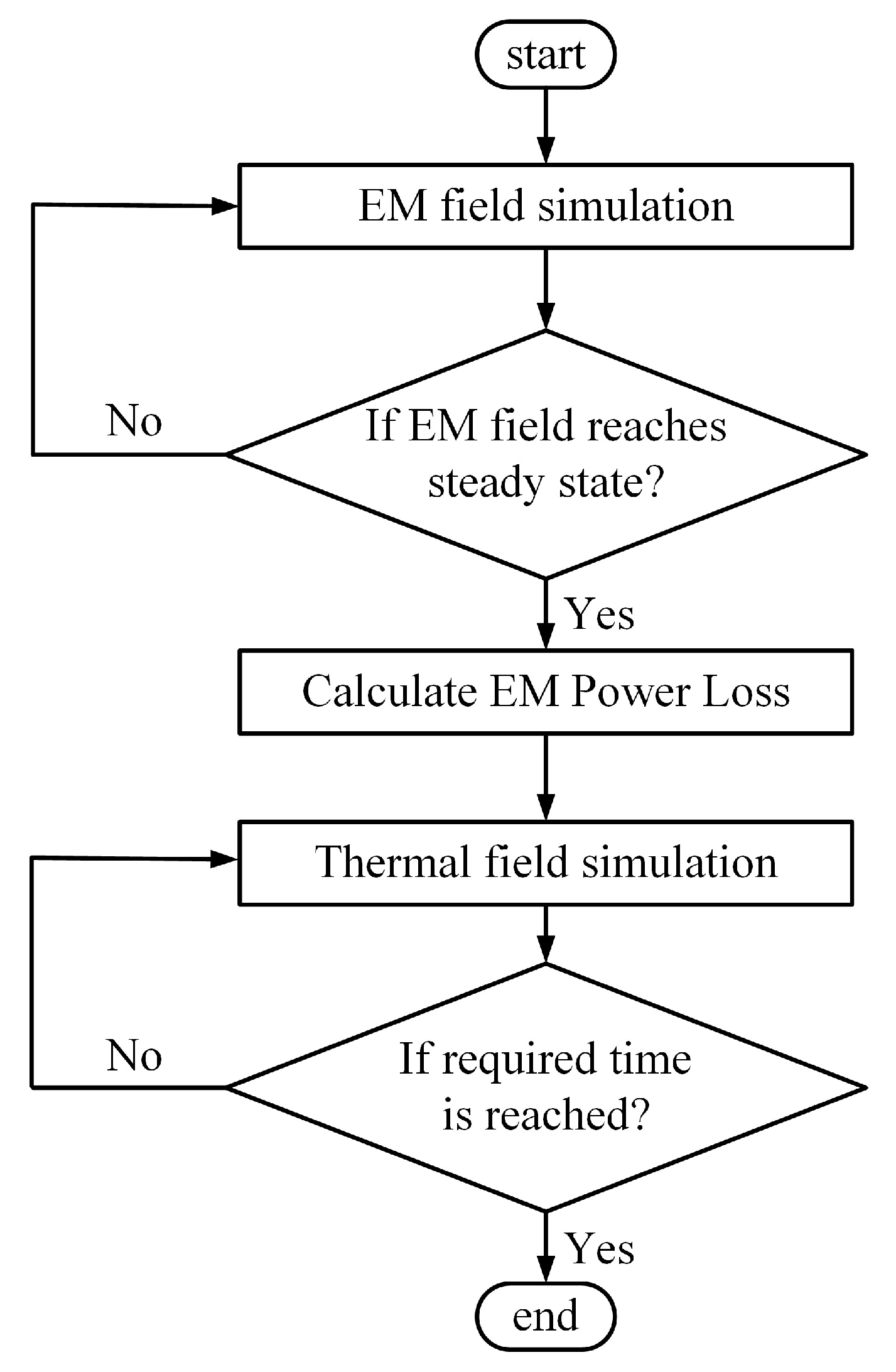

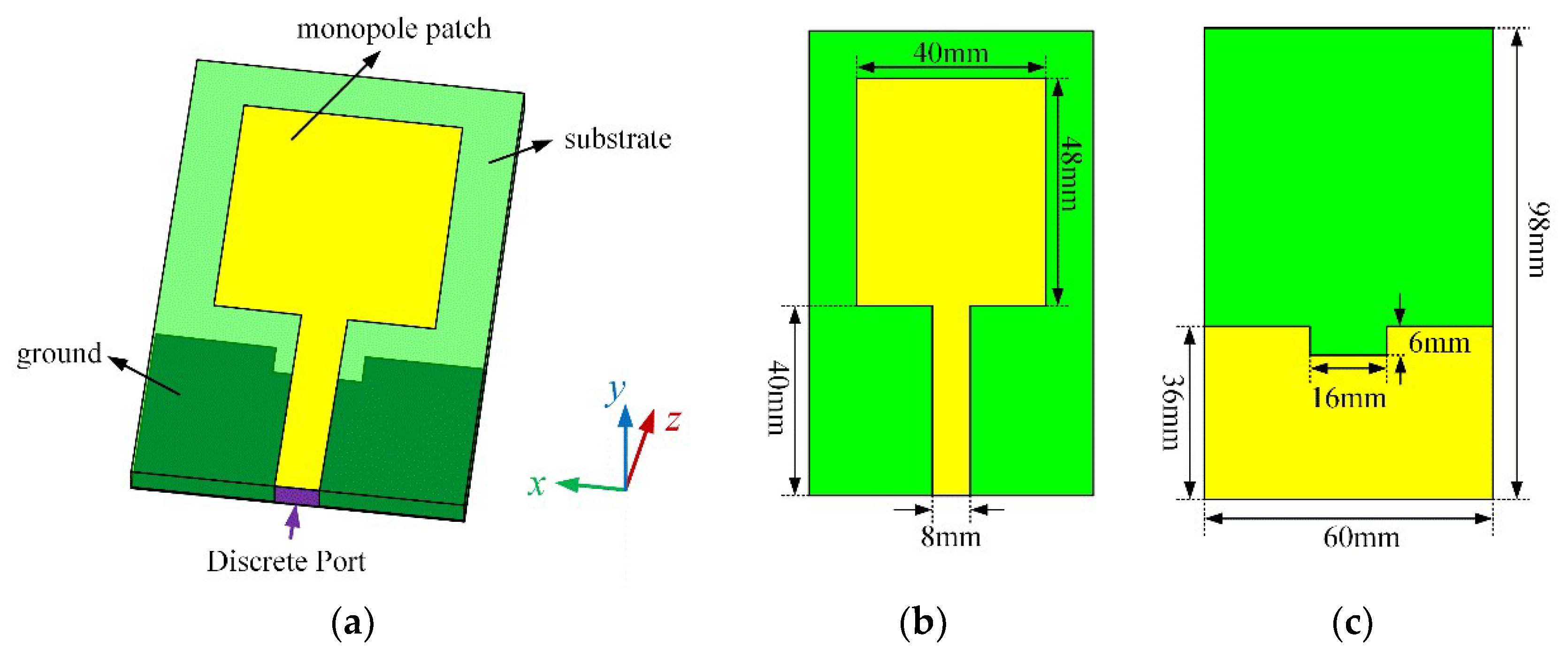
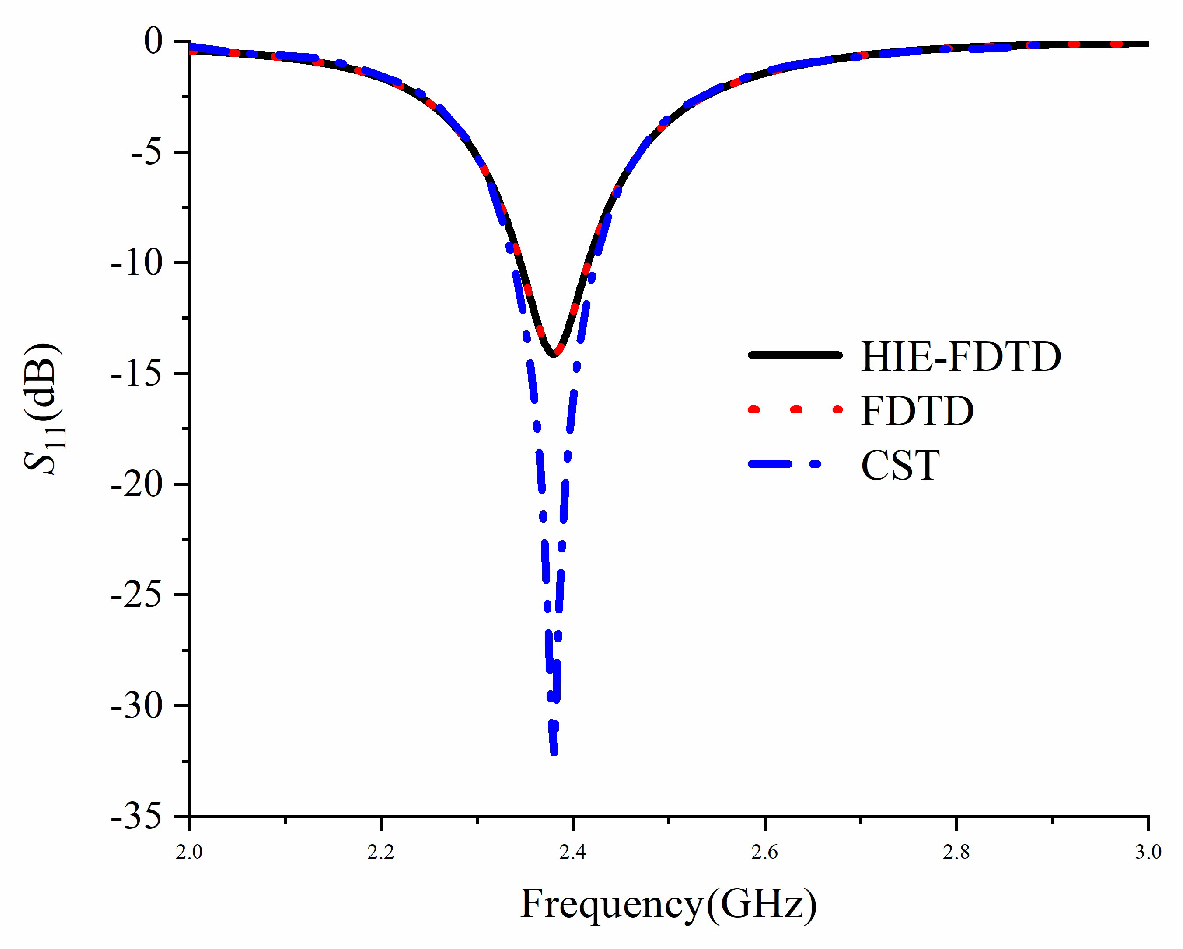
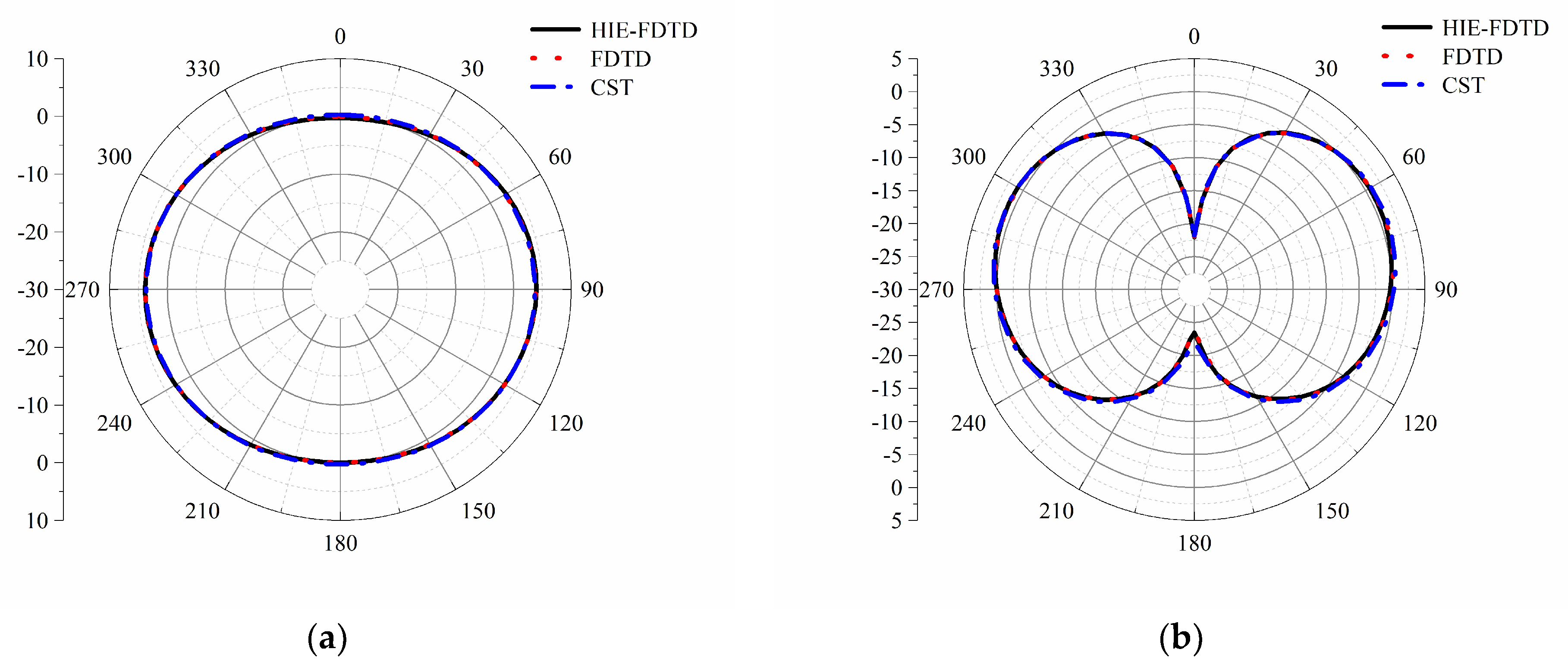

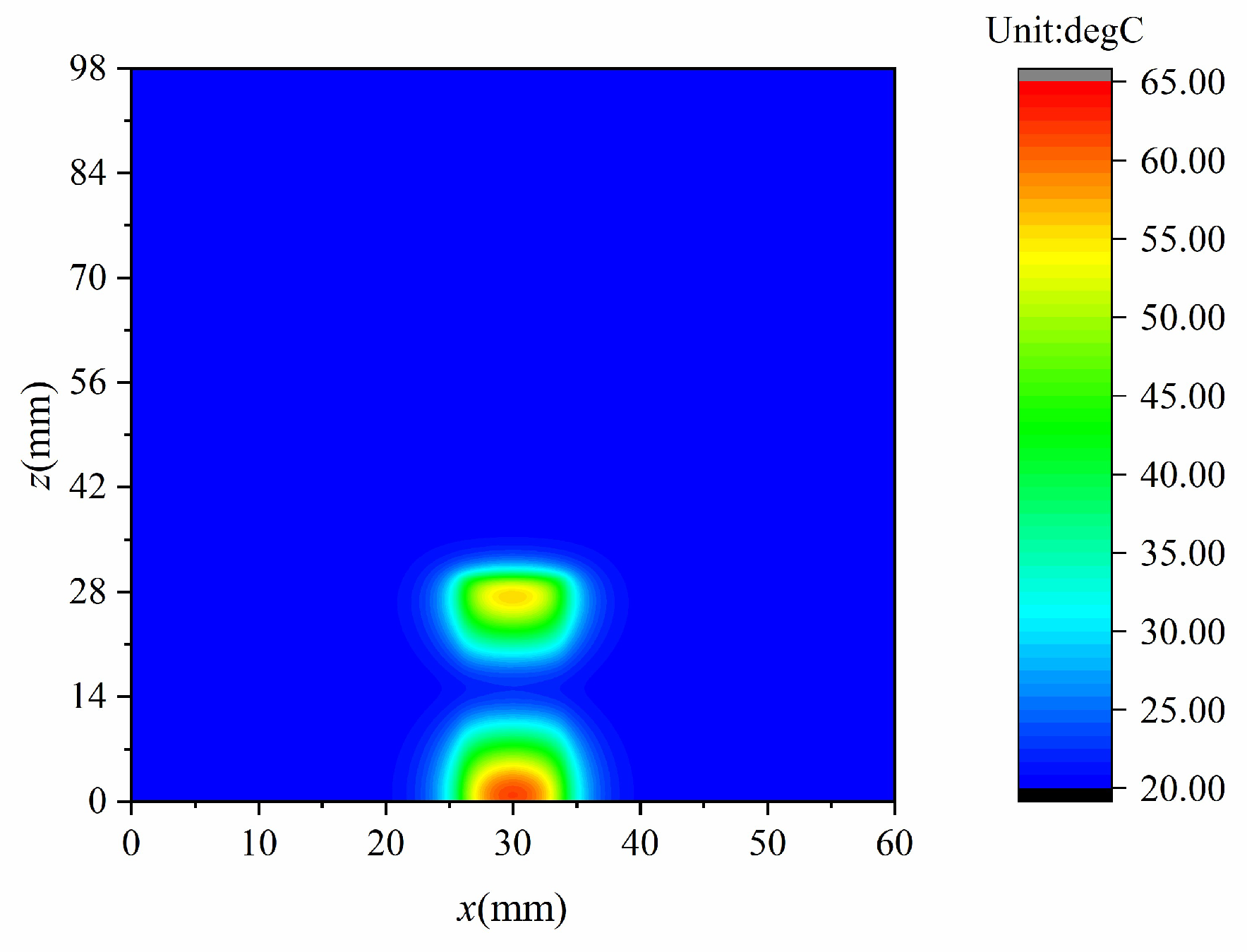
Publisher’s Note: MDPI stays neutral with regard to jurisdictional claims in published maps and institutional affiliations. |
© 2022 by the authors. Licensee MDPI, Basel, Switzerland. This article is an open access article distributed under the terms and conditions of the Creative Commons Attribution (CC BY) license (https://creativecommons.org/licenses/by/4.0/).
Share and Cite
Mou, C.; Chen, J.; Peng, H. Electromagnetic–Thermal Co-Simulation of Planar Monopole Antenna Based on HIE-FDTD Method. Electronics 2022, 11, 4167. https://doi.org/10.3390/electronics11244167
Mou C, Chen J, Peng H. Electromagnetic–Thermal Co-Simulation of Planar Monopole Antenna Based on HIE-FDTD Method. Electronics. 2022; 11(24):4167. https://doi.org/10.3390/electronics11244167
Chicago/Turabian StyleMou, Chunhui, Juan Chen, and Huaiyun Peng. 2022. "Electromagnetic–Thermal Co-Simulation of Planar Monopole Antenna Based on HIE-FDTD Method" Electronics 11, no. 24: 4167. https://doi.org/10.3390/electronics11244167



